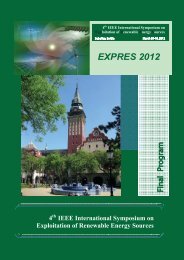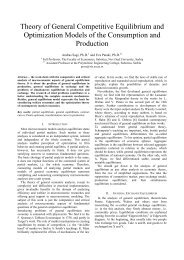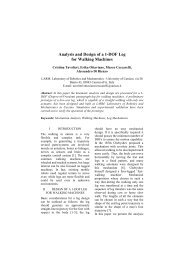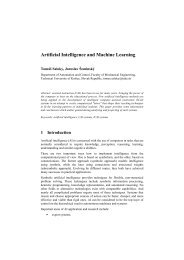Implementing an OCL 2.0 Compiler for ... - ResearchGate
Implementing an OCL 2.0 Compiler for ... - ResearchGate
Implementing an OCL 2.0 Compiler for ... - ResearchGate
Create successful ePaper yourself
Turn your PDF publications into a flip-book with our unique Google optimized e-Paper software.
<strong>an</strong>d (ii) the generation (synthesis) of the target l<strong>an</strong>guage output based on the<br />
retrieved sem<strong>an</strong>tic in<strong>for</strong>mation. Accordingly, the <strong>OCL</strong> <strong>Compiler</strong> realized in<br />
VMTS consists of several parts (Fig. 3). First, the user defines the constraints in<br />
<strong>OCL</strong>, then the constraint definitions are parsed <strong>an</strong>d syntactically <strong>an</strong>alyzed. The<br />
Syntax tree does not contain every necessary in<strong>for</strong>mation, it should be extended<br />
e.g. with type in<strong>for</strong>mation, <strong>an</strong>d implicit self references. This amendment is<br />
per<strong>for</strong>med in the sem<strong>an</strong>tic <strong>an</strong>alysis phase, <strong>an</strong>d it produces the Sem<strong>an</strong>tic Analyzed<br />
Syntax tree. As the next step, the constructed tree is tr<strong>an</strong>s<strong>for</strong>med to a CodeDom<br />
tree. CodeDom is a .NET-based technology that c<strong>an</strong> describe programs using<br />
abstract trees <strong>an</strong>d it c<strong>an</strong> use this tree representation to generate code to <strong>an</strong>y<br />
l<strong>an</strong>guages that is supported by the .NET CLR (like C#, Visual Basic or Java).<br />
Using CodeDom, the generated source code is syntactically correct in all cases;<br />
our task is only to deal with the appropriate sem<strong>an</strong>tic content. Finally, the<br />
compiler tr<strong>an</strong>s<strong>for</strong>ms the CodeDom tree to C# source code, it compiles <strong>an</strong>d builds<br />
it. The output of the <strong>OCL</strong> compiler is a binary executable (a .dll file) that<br />
implements the <strong>OCL</strong> constraint.<br />
Figure 3<br />
The structure of the <strong>OCL</strong> <strong>Compiler</strong><br />
3 The <strong>Compiler</strong><br />
3.1 Lexical Analysis<br />
Lexical <strong>an</strong>d syntactic <strong>an</strong>alysis are realized using the tools Flex [5] <strong>an</strong>d Bison [6].<br />
These tools are optimized <strong>an</strong>d well-tested solutions to syntax tree generation, both<br />
of them were used in thous<strong>an</strong>ds of software projects. Un<strong>for</strong>tunately Flex <strong>an</strong>d<br />
Bison tools use ANSI C code, but they were relative easy to integrate in VMTS.<br />
The first step of the lexical <strong>an</strong>alysis is the tokenization, which parses the source<br />
code <strong>an</strong>d reads lexical patterns (tokens) <strong>for</strong>m it (e.g. identifiers (name) <strong>an</strong>d the<br />
keywords of the l<strong>an</strong>guage). Tokenization eliminates the whitespaces as well as












